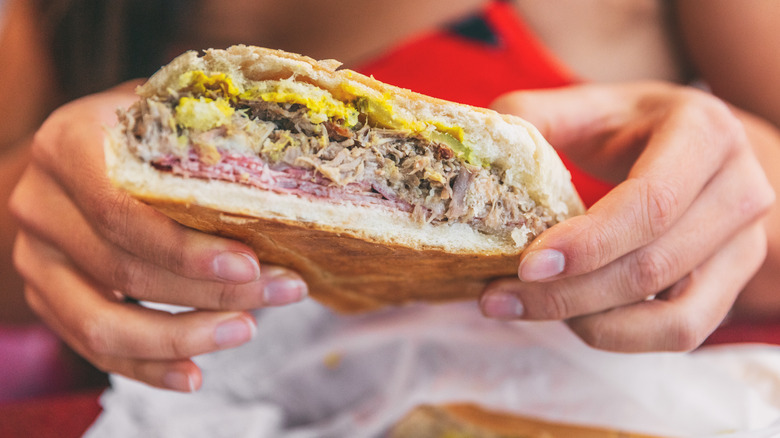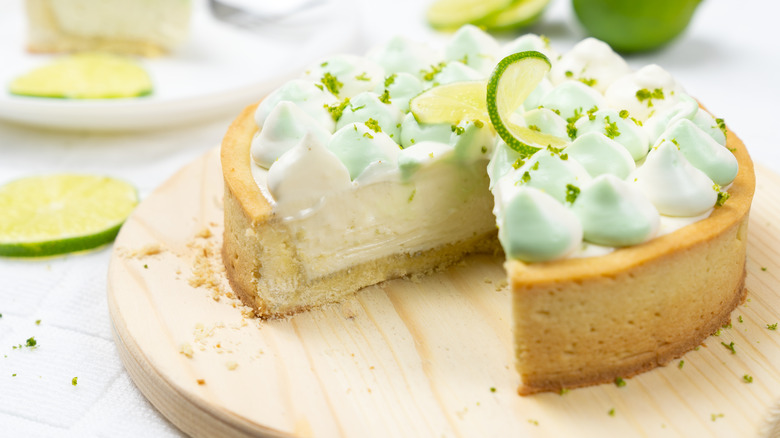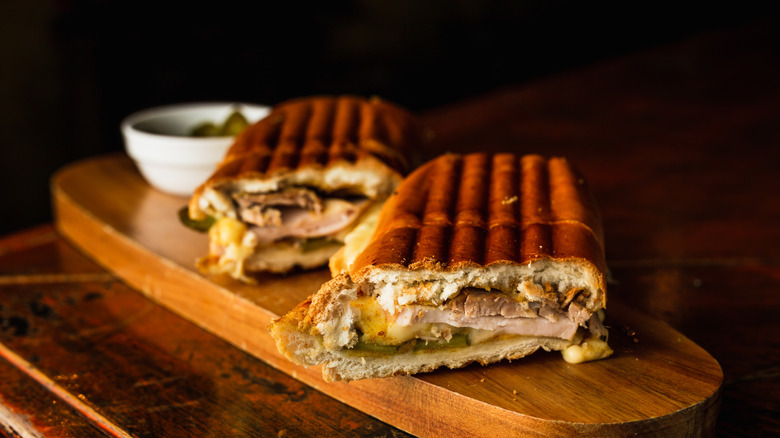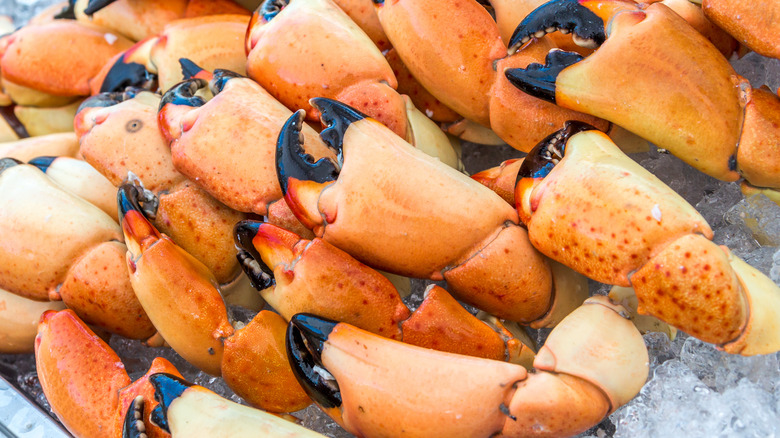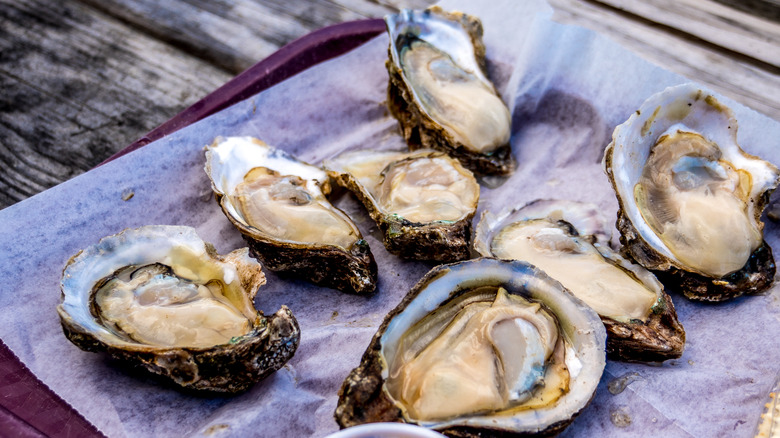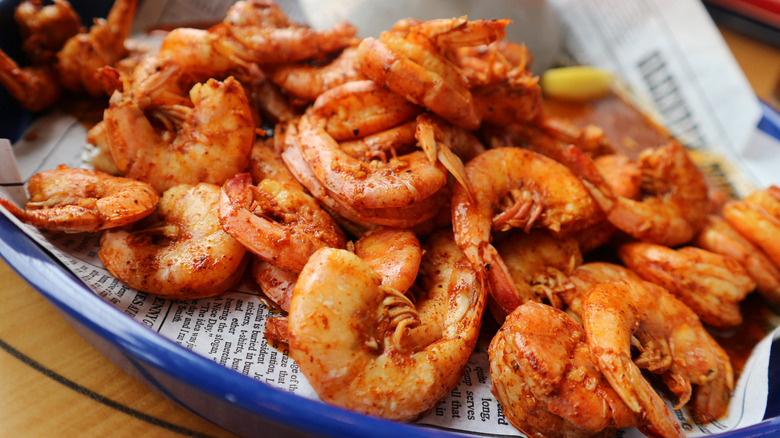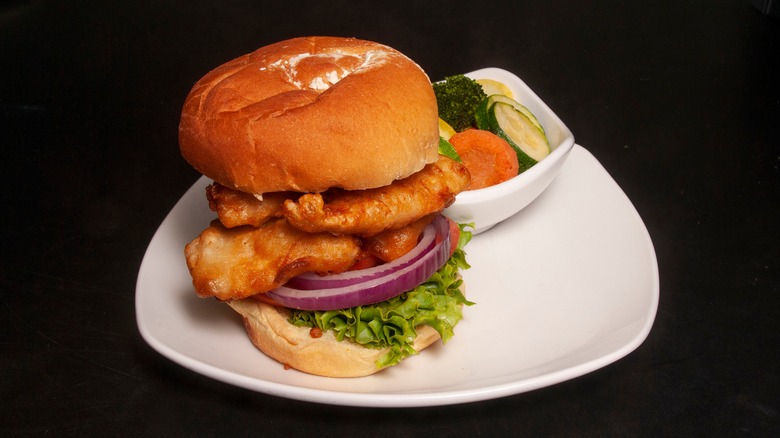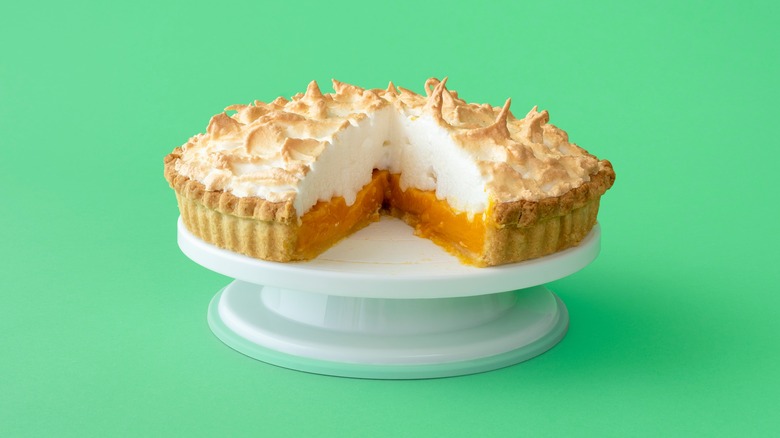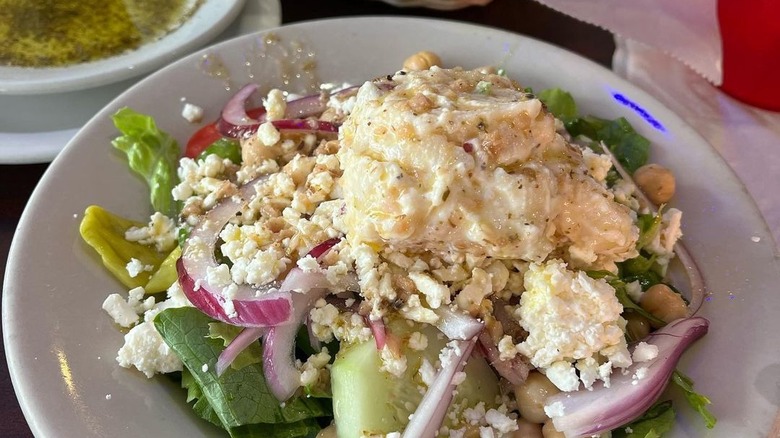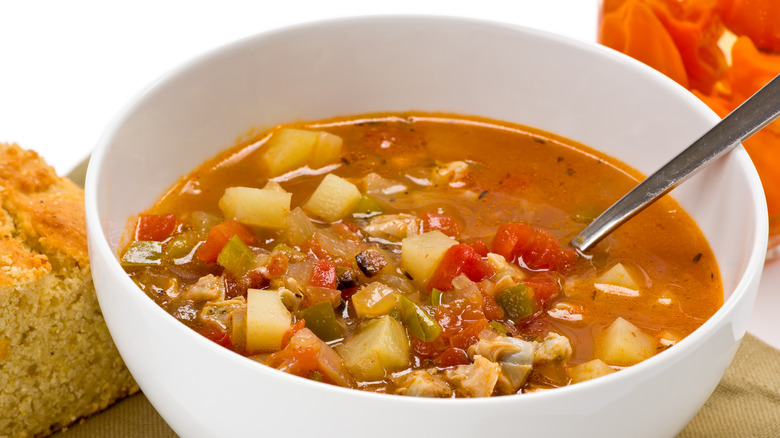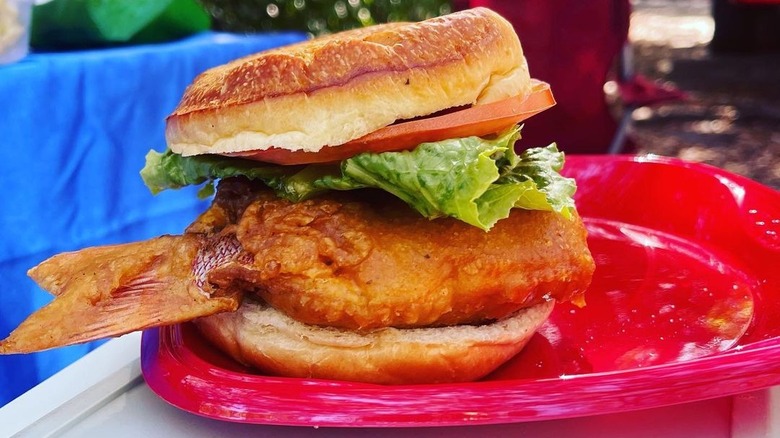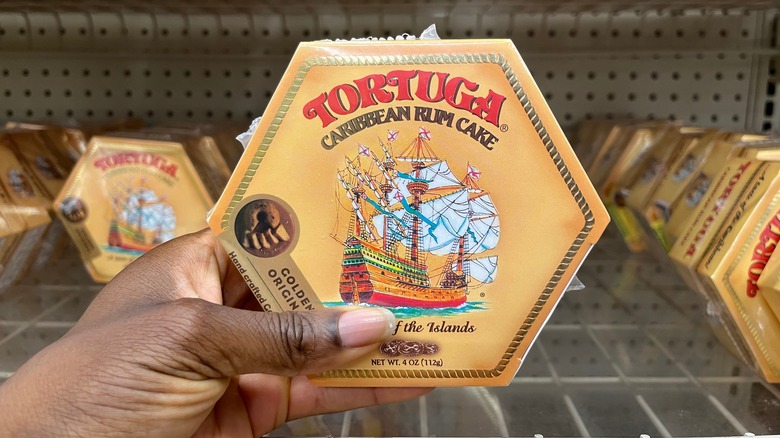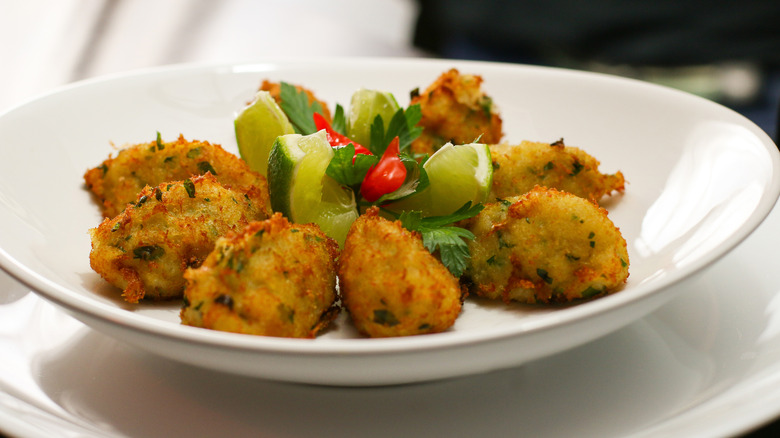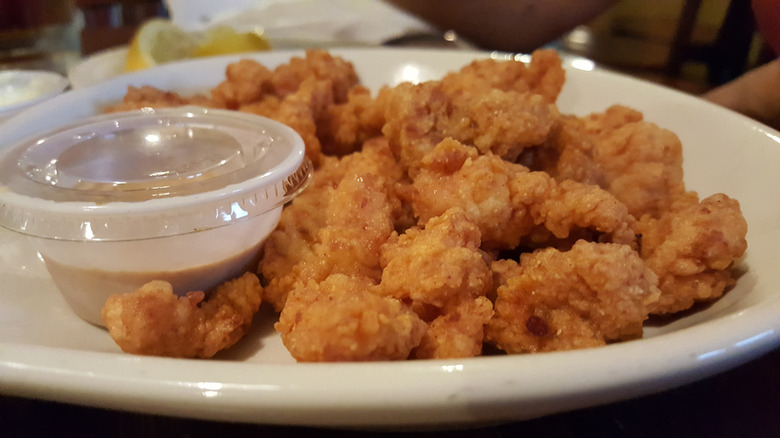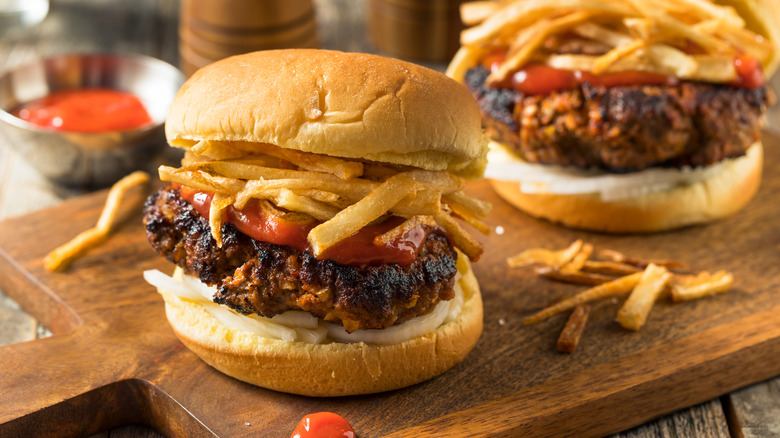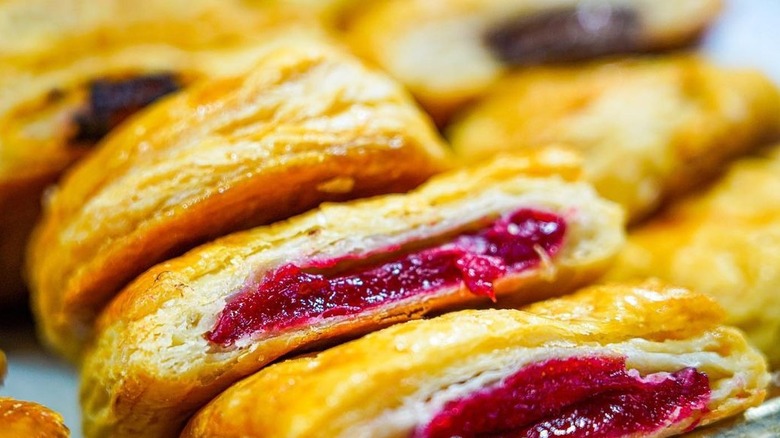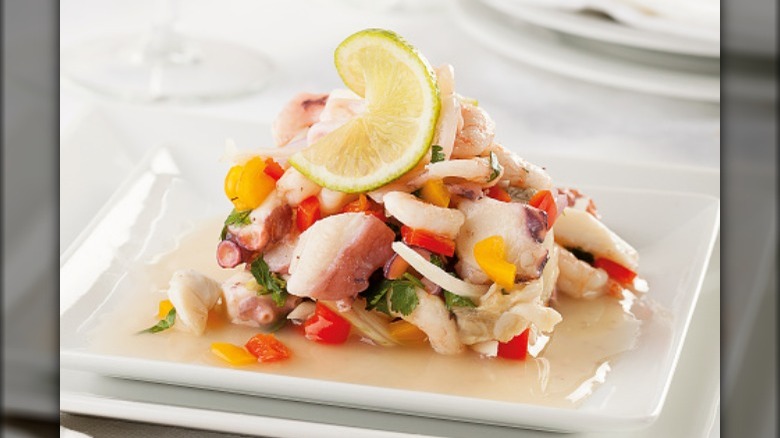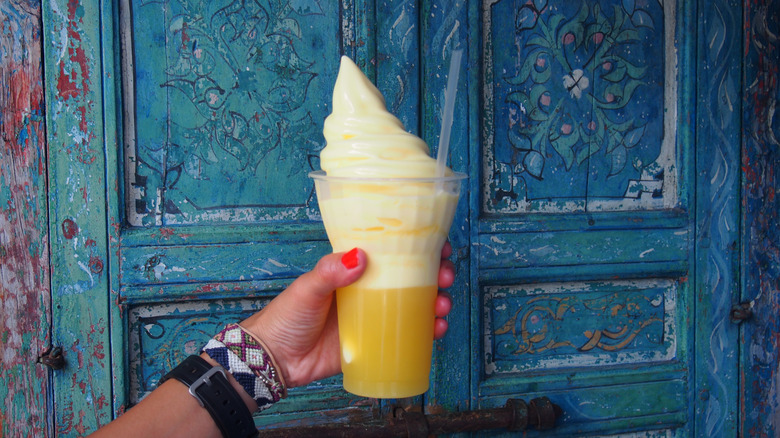17 Iconic Florida Foods You Need To Try
We've all seen the headlines. Florida man steals ribs and puts them down his pants. Florida man eats pancakes in a crosswalk. Florida man breaks into a house and makes a snack.
When the typical Florida man isn't getting arrested because of food, he's probably eating pretty well. Thanks to its many fisheries, Florida has iconic seafood dishes like Minorcan clam chowder and fried grouper sandwiches that, fortunately, anyone can enjoy. The state's bounty of subtropical produce has influenced dishes like key lime and sour orange pie. Florida is also located at a cultural crossroads, and this can be seen in dishes like the Cuban sandwich and Bahamian conch fritters. Clearly, the food in Florida is no joke.
The following iconic foods can and should be tried the next time you're in Florida, but you can also make many of these dishes at home. If you're fortunate enough to live near one, a Latin American grocer will have most or all of the ingredients you need. However, most ingredients can be found in your local supermarket or online.
Key lime pie
Key lime pie is probably the most iconic food from Florida. Before the days of refrigeration, this pie was typically made using only fresh ingredients. At some point, people used sweetened condensed milk from a can as a workaround. However, this approach to making key lime pie was likely made popular thanks to a marketing push from a company that made condensed milk.
Today, key lime pie is pretty easy to make. If you're not from Florida and don't have access to key limes, you might be tempted to use "regular" limes, which are technically known as Persian limes. However, there is a big difference between key limes and Persian limes. Turning yellow when they become ripe, key limes are more aromatic and tarter, making for a more vibrant option for a citrus fruit pie. Pro tip: Adding a bit of white chocolate to the filling will significantly upgrade your key lime pie.
Cuban sandwich
When it comes to food, authenticity is a tricky subject. However, most of us can agree on certain things that make a dish authentic. Just as a New Orleans po'boy must be made with French bread, a Cuban sandwich must be made with a bread called pan Cubano. This sub-style sandwich roll is made with lard, which makes the bread crisp on the outside and soft on the inside. If you don't live near a Latin bakery, you can replicate the sandwich known as a Cubano by using another slightly sweet sub-style roll.
So, what else is in a Cubano? Essential ingredients for the sandwich include roasted pork, ham, Swiss cheese, sour pickles, and mustard. After these ingredients are added to a buttered, sub-style role, the Cubano is toasted in a sandwich press and cut diagonally through the middle.
Stone crab claws
Stone crabs are native to the waters off the Florida coast and are considered a seasonal delicacy. Unlike blue crabs and Dungeness crabs, only the claws of stone crabs are eaten. When stone crabs are caught, crabbers will remove one or both claws, as long as the claws are regulation size, then throw the animals back into the water. The season for harvesting these claws is regulated and the rules around stone crabbing can be restrictive. As a result, stone crab claws are expensive.
This unique harvesting practice helps with sustainability. However, removing one or both of a stone crab's claws will affect its odds of survival after being tossed back into the sea. The claws regenerate, and many stone crabs are able to survive without them (although, it's less common than you might think). If one claw is removed, the crab has a 40% chance of dying as a result, according to the Florida Sea Grant, and if both claws are removed, the mortality rate climbs to 60%. By comparison, stone crabs that are caught and thrown back with both claws have a 13% mortality rate. That being said, stone crab claws probably aren't going anywhere anytime soon.
Apalachicola oysters
A lot of jokes are made at the expense of Florida. It's easy to forget that the state has countless pockets of paradise amidst all the shenanigans and untamed swampland. Located atop rolling dunes along the Gulf Coast, The Shrimp Shack in Seaside, Florida is unquestionably one of those pockets and one of the best classic seafood shacks in the country. It's also renowned for serving Florida's luxurious Apalachicola oysters. Coming from the Apalachicola wildlife region where oysters are still harvested by hand, Apalachicola oysters are prized for marrying an oceanic brininess to a rich, creamy decadence.
Sadly, you will have to wait until at least 2026 to eat an Apalachicola oyster. In 2020, the Florida Fish and Wildlife Conservation Commission placed a moratorium on oyster harvesting in Apalachicola Bay through 2025 due to overharvesting and a decreasing water flow into the bay.
Pink shrimp
There are many shrimp varieties around the world, but pink shrimp that live off the Gulf Coast of Florida are particularly prized for their sweet meat. Referred to as "pink gold" since commercial fishing began in the 1950s, pink shrimp are so distinctive in their color that people have mistaken raw shrimp for cooked shrimp. According to the National Oceanic and Atmospheric Administration, pink shrimp are a sustainable seafood that's available year-round.
A makeshift village on San Carlos Island, located near Fort Myers, popped up in the '50s to service boats that are shrimping for this popular variety, and the little village still bustles to this day. Visitors can watch shrimpers bring their catch in from the dock and eat the freshest pink shrimp at the island's restaurants. Seafood markets in Florida sell pink shrimp fresh or frozen. They can also pack frozen shrimp for air travel, as airport security will allow you to bring properly packed frozen shrimp in your carry-on baggage.
Fried grouper sandwich
Grouper is an absolutely delicious tropical fish that works well in a variety of preparations. It is easily poached, broiled, pan-fried, grilled, or baked. In Florida, it's commonly deep-fried and placed on a bun with lettuce, tomato, and tartar sauce.
Grouper is a meaty and delicious fish that commands a relatively high price point. Because of this, it's a popular target for fish fraud. Unscrupulous people in the supply chain will often try to pass off cheaper, leaner fish like Asian catfish as grouper. Even though this practice is against the law, it's fairly common. Knowing the fish is the best way to protect yourself against grouper fraud.
Compared to other white-fleshed fish, grouper is very meaty and its flesh cooks into large flakes. The flesh doesn't contain intramuscular bones, and the meat has a very little fishy taste, with a flavor slightly reminiscent of chicken. If you purchase grouper in Florida and suspect fish fried, you should contact the Florida Department of Agriculture and Consumer Services. The real deal, however, is worth seeking out.
Sour orange pie
It might be overshadowed by its key lime cousin, but sour orange pie is a Florida classic that shows off the state's range of delicious citrus fruit. Just as the key lime pie is made with pungent and quite sour limes, this pie is a sour dessert made with varieties of oranges that aren't well-suited to being eaten on their own. You can find sour orange pies made with two different types of sour oranges: Seville and calamondin. Seville oranges were brought to Florida by Spanish settlers, while calamondin oranges are native to Southeast Asia. In fact, calamondin oranges are an iconic ingredient in the cuisines of the Philippines — where the fruit is called calamansi.
If you are looking to make sour orange pie at home, simply use sour orange juice as a like-for-like replacement in your favorite key lime pie recipe. The pie can be topped with meringue or fresh whipped cream depending on your personal taste. Although, if your pie filling is on the tart side, you can use the sweetness of whipped cream to balance it out.
Tarpon Springs Greek Salad
When it comes to local food legend, the simplest of things become both iconic and the subject of debate. The Tarpon Springs Greek Salad is famous for having a scoop of potato salad underneath or atop Greek salad ingredients like olives, pepperoncini, tomatoes, lettuce, and feta cheese. Adding a scoop of potato salad might seem like a minor thing that somehow became popular, but its origin story is hotly debated.
According to a story in the Tampa Bay Times, many people say local chef and restauranteur Louis Pappas created the iconic Greek Salad off the cuff, as a way to turn standard Greek salad into a heartier dish. Some versions of the origin story give credit to one of Pappas' Black kitchen workers, alluding to the fact that local Greek and Black populations had cordial relations. Regardless of how it was created, the Tarpon Springs Greek salad is an iconic Florida food you should try.
Minorcan clam chowder
Minorcan clam chowder is an iconic Florida dish coming from the former Spanish colony of Saint Augustine. This tomato-based chowder is made with seafood stock, vegetables, and clams. But, the most essential ingredient is the spicy datil pepper, which was brought to northeast Florida hundreds of years ago. This iconic chowder with Mediterranean influence was developed by settlers from the Spanish island of Minorca who worked on Florida's indigo plantations.
Chowder dates back longer than you might expect and it's a uniquely American invention with different regional varieties. The two most famous examples are the tomato-based Manhattan clam chowder and cream-based New England clam chowder. Debates over chowder can be pretty intense and at one point a clearly spiteful Maine politician tried to make it illegal to add tomatoes to New England clam chowder. While chowders in the northeast typically use the quahog clam, Floridan chowders are more likely to use the state's iconic Cedar Key clams.
Pan con minuta
Fish sandwiches get short shrift. McDonald's create its famous Filet O' Fish sandwich out of desperation, as a way to bring in Catholics abstaining from meat during Lent. However, Floridians love a good fish sandwich and the state's most iconic is the pan con minuta.
Popularized by Cuban immigrants, this fish sandwich is made with a snapper filet that has been butterflied, battered, and deep-fried. But, the most iconic part of the pan con minuta is the fact that the filet still has the fishtail attached. There are a number of ways to dress the sandwich. Some restaurants serve it with chopped tomatoes, chopped onions, and tartar sauce, while others simply serve it with ketchup and onions. Most people agree that the fish and any toppings must be served on Cuban-style bread for the sandwich to be a proper pan com minuta. The best area to get this iconic Florida sandwich is in Miami's vibrant Little Havana neighborhood.
Rum cake
Rum cakes came to Florida from the Caribbean, and the most common way to get your hands on these spicy-sweet treats is to buy one from the iconic Tortuga Rum Cake Company. Founded in the Cayman Islands, the company opened a distribution hub in Miami in 1997. Since then, the company's rum cakes have become both a local treat and a must-have edible souvenir for anyone visiting Florida and the Caribbean.
But, you don't have to go to Florida to enjoy this iconic dessert because rum cake is one of the easiest cakes to make. All you need is white cake mix, a package of instant vanilla or banana cream pudding, four eggs, and one-half cup of water, rum, and vegetable oil. Simply mix and bake the batter in a Bundt cake pan.
To be clear, this type of pan can be tricky to work with. If your cake won't come out of the bundt pan, first make sure it's cooled properly. Then, place a clean kitchen towel on a table or countertop, flip the pan upside down over the towel, and give it a good smack.
Conch fritters
Conch is a type of sea snail that's a popular food in the Bahamas. In Florida, conch fritters are a popular restaurant menu item. So, what does conch taste like? A good way to describe the conch's sweet-salty meat is a cross between scallop and squid meat.
Conch fritters are a popular preparation because it involves finely chopping the sea snail's meat, which can be quite tough. The meat is also difficult to extract from the shell, making it important to get the most out of every catch. The chopped conch meat is typically combined with chopped bell peppers, tomatoes, onions, celery, and various seasonings. While you can find conch fritters throughout Florida, they are a must-have dish in Key West. They are often served with a key lime mustard, which cuts through the richness of fried conch meat.
Fried gator bites
While, today, unfamiliar diners might take pause with reptile for an entree, alligator meat was so popular that widespread alligator hunting in the middle of the 20th century placed the reptiles on the endangered species List. Today, the alligator meat you buy in a store or restaurant comes from alligator farms, even though the reptiles were removed from the Endangered Species List in 1987.
Yes, it's a cliché but alligator meat does taste like chicken. Why is that the case? It's due to the fact that chickens and alligators likely share a common ancestor: dinosaurs. So, would dinosaur meat taste like chicken? Given the fact that Jurassic Park is not a documentary, you'll probably never find out. But, let us know if you do.
Frita Cubana
The Frita Cubana is a distinctive style of hamburger from Cuba that Florida has made all its own. As with many iconic foods, there are many variations on the frita cubana. However, the burger is defined by a Cuban-style roll with a crisp crust; a beef patty spiced with paprika, cumin, and pepper; chopped white onions; and crispy fried potato strings. The frita cubana as we know it today originated in the early 20th century as a street food in Cuba. Street vendors would sell slider-sized fritas cubanas as an afternoon snack to hungry workers.
Burger Beast says that the burger was brought to Miami in 1961 when the restaurant Fritas Domino started selling them in Miami's Little Havana neighborhood. Although the restaurant had multiple locations at one point, the last Fritas Domino closed in 2021.
Guava pastelito
Cuban bakeries are renowned for their sweets, especially their pastelitos. These flaky pastries come with all kinds of filling and the most iconic are guava pastelitos, which come filled with guava preserve and cheese or simply with the preserve. If you walk into a Cuban bakery, you can tell the fillings of different guava pastelitos based on their shape. Cuban-style triangular pastelitos are filled with both guava and cheese, while rectangular pastelitos contain can be found in Puerto Rico, according to Fine Dining Lovers.
Obviously, if you make these at home, you can give them any shape you like. Latin grocery stores typically sell guava preserve for these pastelitos. However, you can make it yourself with fresh guava, water, sugar, and gelatin or another thickener. You can tell when fresh guava is ripe by the way it gives a little when squeezed. Guava that is particularly soft is very ripe and very sweet.
Ceviche
Ceviche is a dish of raw fish and vegetables that is slightly cooked by marinating in an acidic bath of citrus juice. While versions of ceviche can be found in many different countries, the two most popular are Peruvian and Mexican ceviche. In Peru, ceviche is typically made with seabass or sole and includes a few vegetables, such as onion and aji pepper, and sometimes white corn called choclo. In Mexico, ceviche is typically made with shrimp or tuna and usually has more ingredients, including jalapeños, tomatoes, onions, and cilantro.
If you want to make this dish at home, the best types of fish for ceviche are firm, white fish like cod or mahi-mahi, which can tolerate an acidic marinade. More important than the type of fish is choosing fresh, sushi-grade seafood to make ceviche. This will provide good flavor, and minimize your risk of exposure to harmful pathogens.
Dole Whip
We often don't think of Walt Disney when we think of iconic foods, but the Dole Whip at Walt Disney World is an iconic Florida food. In 1976, Dole became an official sponsor of the Enchanted Tiki Room attraction in Disneyland. That partnership inspired Dole to create a frozen tree that tasted like fresh fruit and resisted the heat found in Disney's California and Florida theme parks. Disney's famous Dole Whip debuted at Disney World in 1984 and Disneyland in 1986. Although the frozen treat didn't get much respect at Dole when it first came out, Dole Whip became a runaway hit, ultimately getting the respect it deserves. The frozen treat now has its own special Dole Whip Day at both Disney parks.
